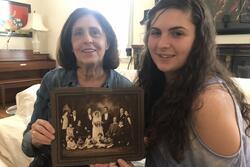JIMENA's New Sephardi and Mizrahi Education Toolkit
JWA talks to Sarah Levin, executive director for Jews Indigenous to the Middle East and North Africa (JIMENA) about its new Sephardi and Mizrahi Education Toolkit. The toolkit includes recommendations, strategies, and resources that Jewish educators can use to be inclusive of Sephardi and Mizrahi heritage.
JWA: How does JIMENA’s Sephardi and Mizrahi Education toolkit address gaps in Jewish education?
Sarah Levin: The toolkit offers a comprehensive resource for educators across various disciplines and school administrators to evaluate their school's culture and obtain recommendations and materials for the effective incorporation of Sephardi and Mizrahi content into classrooms and schools. The school culture recommendations are tailored for programming personnel, guidance staff, lay leaders, school leaders, and families.
JWA: One of the recommendations in the toolkit is for educators to ask students about their roots. Why is this important?
Sarah: A fundamental aspect of Sephardi and Mizrahi pedagogy is the commitment to meet students and families where they are, fostering schools that are inclusive and welcoming to students from a spectrum of socio-economic backgrounds. The Sephardi and Mizrahi educators within the JIMENA network have underscored the importance of recognizing and including every child, irrespective of ethnicity. A key component of adopting a Sephardi approach involves empowering students to take pride in their family background and heritage. It's crucial for our classrooms to avoid creating divisions among students based on ethnic origins. So we encourage teachers to inspire students to embrace their heritage, which is deeply rooted in their familial histories, no matter where those histories originated.
JWA: For topics like the Holocaust, what are some ways the toolkit bridges the knowledge gap between Ashkenazi and non-Ashkenazi history?
SL: Holocaust history is an integral part of Jewish history, yet, regrettably, many Jewish educators lack knowledge of Nazism's impact across the Middle East, as well as the experiences of North African and Sephardi Jews during World War II. The toolkit includes a comprehensive section specifically devoted to this subject, and we're continually augmenting it with new materials. Our Holocaust section is designed as much to educate the educators as it is to equip them with the necessary resources to impart this lesser-known facet of the Holocaust.
JWA: How can parents and students use the toolkit to advocate for the inclusion of Sephardi and Mizrahi studies in the classroom?
SL: I believe the initial step is for both parents and students to recognize that the issue at hand extends beyond occasional inclusion within the school environment—it’s about the importance of seeing Sephardi and Mizrahi heritage reflected consistently, within each and every school unit, which is undeniably vital if we really want to develop inclusive schools. However, it’s also about insisting that our schools offer a comprehensive and rigorous curriculum that genuinely represents the full spectrum of Jewish heritage, history, culture, experiences, and philosophical perspectives. The contributions and legacy of Sephardi and Mizrahi Jews span millennia and form the bedrock of contemporary Jewish practice. Also, the teachings of Sephardi and Mizrahi rabbis and leaders hold significant relevance and offer practical approaches to addressing today’s challenges. So it's unacceptable to relegate Sephardi and Mizrahi history and heritage to the status of an exotic addition. Parents should actively advocate for the integration of Sephardi and Mizrahi content into every aspect of a school's educational framework.
JWA: In 2018, JIMENA launched its first Mizrahi curriculum. Can you talk about the success of this program, and how you hope to build on this success with the new Sephardi and Mizrahi Education toolkit?
SL: Our "Journey to the Mizrah" curriculum was initially piloted in San Francisco, aiming to provide a straightforward twelve-part curriculum that we assisted local schools in incorporating into their classrooms. We deliberately designed the curriculum to be as accessible as possible for educators worldwide, and I’m proud to say that over 800 educators across eight different countries have used the lesson plans and materials. We recognized the substantial need for educational resources on Sephardi and Mizrahi topics even before the curriculum's development, and its success has not come as a surprise.
We aim to offer training and support to teachers and administrators in need of assistance with both educational content and school culture. We’re also excited about the introduction of a Sephardi Leaders Cohort, specifically for Jewish educators. The toolkit is designed to be a dynamic document, with plans for ongoing expansion, as it stands unparalleled in the field. Our objective is for every teacher and school to embrace this curriculum, recognizing that this history is also their history. It's crucial for the preparation of our Jewish students for the future, equipped with the knowledge we aim to share.
We also encourage many school teachers and administrators to "unlearn" some of their preconceived notions about Sephardi and Mizrahi Jews, paving the way for genuine engagement, learning, and teaching. A profound, systemic effort is required from Jewish higher educational institutions to evaluate the effectiveness of their instruction on these subjects to future Jewish educators. This entails making necessary adjustments to their curriculum and methodologies concerning these topics.
JWA: The definitions of Sephardi and Mizrahi Jews have been a contentious topic in the Jewish community. How does the curriculum address this issue? Can you provide an example of how the toolkit is mindful of the different identities that Sephardi and Mizrahi students have?
SL: As mentioned in the toolkit, there is no widespread consensus on the terms "Sephardi" and "Mizrahi," as they are relatively new, and their meanings vary from one person to another. Scholars have employed a range of geographic, linguistic, religious, and cultural criteria to decide who fits within these categories. The toolkit adopts an inclusive approach, acknowledging the validity of the various definitions presented.
JWA: Can you talk about any future plans for the toolkit?
SL: On March 26 and 27, the authors of the toolkit will lead a training session for educators and administrators, essentially providing a walk-through of the toolkit. We will continuously add to the toolkit and look forward to recruiting a national cohort of formal Jewish educators for our Sephardi Leaders Fellowship. The curriculum for our fellowship will be modified to better suit the needs of a cohort of educators. We’re interested in exploring more significant interventions in Jewish higher education so that every Jewish educator feels prepared and well-equipped to integrate Sephardi and Mizrahi content into each and every unit they teach.








